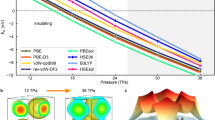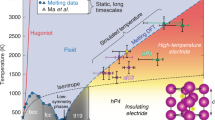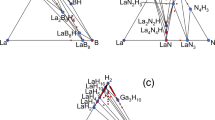Abstract
Helium is generally understood to be chemically inert and this is due to its extremely stable closed-shell electronic configuration, zero electron affinity and an unsurpassed ionization potential. It is not known to form thermodynamically stable compounds, except a few inclusion compounds. Here, using the ab initio evolutionary algorithm USPEX and subsequent high-pressure synthesis in a diamond anvil cell, we report the discovery of a thermodynamically stable compound of helium and sodium, Na2He, which has a fluorite-type structure and is stable at pressures >113 GPa. We show that the presence of He atoms causes strong electron localization and makes this material insulating. This phase is an electride, with electron pairs localized in interstices, forming eight-centre two-electron bonds within empty Na8 cubes. We also predict the existence of Na2HeO with a similar structure at pressures above 15 GPa.
This is a preview of subscription content, access via your institution
Access options
Access Nature and 54 other Nature Portfolio journals
Get Nature+, our best-value online-access subscription
$29.99 / 30 days
cancel any time
Subscribe to this journal
Receive 12 print issues and online access
$259.00 per year
only $21.58 per issue
Buy this article
- Purchase on SpringerLink
- Instant access to full article PDF
Prices may be subject to local taxes which are calculated during checkout




Similar content being viewed by others
References
Stevenson, D. J. Metallic helium in massive planets. Proc. Natl Acad. Sci. USA 105, 11035–11036 (2008).
Huheey, J. E., Keiter, E. A., Keiter, R. L. & Medhi, O. K. Inorganic Chemistry: Principles of Structure and Reactivity (Harper & Row, 1983).
Hotop, H. & Lineberger, W. C. Binding energies in atomic negative ions: II. J. Phys. Chem. Ref. Data 14, 731–750 (1985).
Hiby, J. W. Massenspektrographische untersuchungen an wasserstoff- und heliumkanalstrahlen (H3+, H2−, HeH+, HeD+, He−). Annalen der Physik 426, 473–487 (1939).
Wong, M. W. Prediction of a metastable helium compound: HHeF. J. Am. Chem. Soc. 122, 6289–6290 (2000).
Grochala, W. On chemical bonding between helium and oxygen. Pol. J. Chem. 83, 87–122 (2009).
Tariq, N., Taisan, N. A., Singh, V. & Weinstein, J. D. Spectroscopic detection of the LiHe molecule. Phys. Rev. Lett. 110, 153201 (2013).
Loubeyre, P., Jean-Louis, M., LeToullec, R. & Charon-Gérard, L. High pressure measurements of the He-Ne binary phase diagram at 296 K: evidence for the stability of a stoichiometric Ne(He)2 solid. Phys. Rev. Lett. 70, 178–181 (1993).
Liu, H., Yao, Y. & Klug, D. D. Stable structures of He and H2O at high pressure. Phys. Rev. B 91, 014102 (2015).
Hermann, A. & Schwerdtfeger, P. Xenon suboxides stable under pressure. J. Phys. Chem. Lett. 5, 4336–4342 (2014).
Zhu, Q. et al. Stability of xenon oxides at high pressures. Nat. Chem. 5, 61–65 (2013).
Miao, M.-s. et al. Anionic chemistry of noble gases: formation of Mg–NG (NG = Xe, Kr, Ar) compounds under pressure. J. Am. Chem. Soc. 137, 14122–14128 (2015).
Ma, Y. et al. Transparent dense sodium. Nature 458, 182–185 (2009).
Zhang, W. et al. Unexpected stable stoichiometries of sodium chlorides. Science 342, 1502–1505 (2013).
Lyakhov, A. O., Oganov, A. R. & Valle, M. in Modern Methods of Crystal Structure Prediction (ed. Oganov, A.R.) 147–180 (Wiley-VCH 2010).
Oganov, A. R. & Glass, C. W. Crystal structure prediction using ab initio evolutionary techniques: principles and applications. J. Chem. Phys. 124, 244704 (2006).
Gerward, L. et al. X-ray diffraction investigations of CaF2 at high pressure. J. Appl. Crystallogr. 25, 578–581 (1992).
Gregoryanz, E. et al. Structural diversity of sodium. Science 320, 1054–1057 (2008).
Hanfland, M., Loa, I. & Syassen, K. Sodium under pressure: bcc to fcc structural transition and pressure–volume relation to 100 GPa. Phys. Rev. B 65, 184109 (2002).
Marqués, M. et al. Optical and electronic properties of dense sodium. Phys. Rev. B 83, 184106 (2011).
Santamaría-Pérez, D., Mukherjee, G. D., Schwager, B. & Boehler, R. High-pressure melting curve of helium and neon: deviations from corresponding states theory. Phys. Rev. B 81, 214101 (2010).
Gregoryanz, E., Degtyareva, O., Somayazulu, M., Hemley, R. J. & Mao, H.-k. Melting of dense sodium. Phys. Rev. Lett. 94, 185502 (2005).
Somayazulu, M. et al. Pressure-induced bonding and compound formation in xenon–hydrogen solids. Nat. Chem. 2, 50–53 (2010).
Miao, M.-S. & Hoffmann, R. High pressure electrides: a predictive chemical and physical theory. Acc. Chem. Res. 47, 1311–1317 (2014).
Miao, M.-S. & Hoffmann, R. High-pressure electrides: the chemical nature of interstitial quasiatoms. J. Am. Chem. Soc. 137, 3631–3637 (2015).
Dye, J. L. Electrons as anions. Science 301, 607–608 (2003).
Shannon, R. D. & Prewitt, C. T. Effective ionic radii in oxides and fluorides. Acta Crystallogr. B 25, 925–946 (1969).
Rousseau, B. & Ashcroft, N. W. Interstitial electronic localization. Phys. Rev. Lett. 101, 046407 (2008).
Pauling, L. The principles determining the structure of complex ionic crystals. J. Am. Chem. Soc. 51, 1010–1026 (1929).
Bader, R. F. W. Atoms in Molecules – A Quantum Theory (Univ. Oxford Press, 1990).
Henkelman, G., Arnaldsson, A. & Jónsson, H. A fast and robust algorithm for Bader decomposition of charge density. Comput. Mater. Sci. 36, 354–360 (2006).
Galeev, T. R., Dunnington, B. D., Schmidt, J. & Boldyrev, A. I. Solid state adaptive natural density partitioning: a tool for deciphering multi-center bonding in periodic systems. Phys. Chem. Chem. Phys. 15, 5022–5029 (2013).
Zubarev, D. Y. & Boldyrev, A. I. Developing paradigms of chemical bonding: adaptive natural density partitioning. Phys. Chem. Chem. Phys. 10, 5207–5217 (2008).
Dunnington, B. D. & Schmidt, J. R. Generalization of natural bond orbital analysis to periodic systems: applications to solids and surfaces via plane-wave density functional theory. J. Chem. Theory Comput. 8, 1902–1911 (2012).
Foster, J. P. & Weinhold, F. Natural hybrid orbitals. J. Am. Chem. Soc. 102, 7211–7218 (1980).
Dronskowski, R. & Blöchl, P. E. Crystal orbital Hamilton populations (COHP): energy-resolved visualization of chemical bonding in solids based on density-functional calculations. J. Phys. Chem. 97, 8617–8624 (1993).
Andersen, O. K. & Jepsen, O. Explicit, first-principles tight-binding theory. Phys. Rev. Lett. 53, 2571–2574 (1984).
Winzenick, M., Vijayakumar, V. & Holzapfel, W. B. High-pressure X-ray diffraction on potassium and rubidium up to 50 GPa. Phys. Rev. B 50, 12381–12385 (1994).
Dye, J. L. Electrides: early examples of quantum confinement. Acc. Chem. Res. 42, 1564–1572 (2009).
Vegas, Á. & Mattesini, M. Towards a generalized vision of oxides: disclosing the role of cations and anions in determining unit-cell dimensions. Acta Crystallogr. B 66, 338–344 (2010).
Oganov, A. R. et al. Ionic high-pressure form of elemental boron. Nature 457, 863–867 (2009).
Perdew, J. P., Burke, K. & Ernzerhof, M. Generalized gradient approximation made simple. Phys. Rev. Lett. 77, 3865–3868 (1996).
Blöchl, P. E. Projector augmented-wave method. Phys. Rev. B 50, 17953–17979 (1994).
Kresse, G. & Furthmüller, J. Efficiency of ab-initio total energy calculations for metals and semiconductors using a plane-wave basis set. Comput. Mater. Sci. 6, 15–50 (1996).
Dovesi, R. et al. CRYSTAL14 User's Manual (Univ. of Torino, 2014).
Gatti, C., Saunders, V. R. & Roetti, C. Crystal field effects on the topological properties of the electron density in molecular crystals: the case of urea. J. Chem. Phys. 101, 10686–10696 (1994).
Krier, G., Jepsen, O., Burkhardt, A. & Andersen, O. K. The TB-LMTO-ASA Program (Max-Planck-Institute for Solid State Research, 1995).
Togo, A., Oba, F. & Tanaka, I. First-principles calculations of the ferroelastic transition between rutile-type and CaCl2-type SiO2 at high pressures. Phys. Rev. B 78, 134106 (2008).
Akahama, Y. & Kawamura, H. High-pressure Raman spectroscopy of diamond anvils to 250 GPa: method for pressure determination in the multimegabar pressure range. J. Appl. Phys. 96, 3748–3751 (2004).
McMahon, J. M., Morales, M. A., Pierleoni, C. & Ceperley, D. M. The properties of hydrogen and helium under extreme conditions. Rev. Mod. Phys. 84, 1607–1653 (2012).
Akahama, Y. & Kawamura, H. Pressure calibration of diamond anvil Raman gauge to 310 GPa. J. Appl. Phys. 100, 043516 (2006).
Loubeyre, P. et al. Equation of state and phase diagram of solid 4He from single-crystal X-ray diffraction over a large P–T domain. Phys. Rev. Lett. 71, 2272–2275 (1993).
Shishkin, M. & Kresse, G. Self-consistent GW calculations for semiconductors and insulators. Phys. Rev. B 75, 235102 (2007).
Acknowledgements
This work was supported by the China Scholarship Council (grant no. 201206200030), NSAF (grant no. U1530402), National Science Foundation (grant no. EAR-1114313), DARPA (grant no. W31P4Q1210008), Russian Science Foundation (grant no. 16-13-10459), National 973 Program of China (grant no. 2012CB921900) and Foreign Talents Introduction and Academic Exchange Program (grant no. B08040). X.F.Z. acknowledges funding from the National Science Foundation of China (grant no. 11674176). Calculations were performed at the Tianhe II supercomputer in Guangzhou and the supercomputer of the Center for Functional Nanomaterials, Brookhaven National Laboratory, which is supported by the US Department of Energy, Office of Basic Energy Sciences, under contract no. DE-AC02-98CH10086. GeoSoilEnviroCARS is supported by the National Science Foundation – Earth Sciences (EAR-1128799) and Department of Energy – Geosciences (DE-FG02-94ER14466). Use of the Advanced Photon Source was supported by the US Department of Energy, Office of Science, Office of Basic Energy Sciences, under contract no. DE-AC02-06CH11357. PETRA III at DESY is a member of the Helmholtz Association (HGF). The research leading to these results has received funding from the European Community's Seventh Framework Programme (FP7/2007- 2013) under grant agreement no. 312284. The work of E.S. was performed under the auspices of the US Department of Energy by Lawrence Livermore National Security under contract no. DE-AC52-07NA27344. A.F.G. acknowledges support from the National Natural Science Foundation of China (grant no. 21473211), the Chinese Academy of Sciences (grant no. YZ201524) and the Chinese Academy of Sciences visiting professorship for senior international scientists (grant no. 2011T2J20) and Recruitment Program of Foreign Experts. S.L. was partly supported by state assignment project no. 0330-2016-0006. A.I.B. acknowledges the support of the National Science Foundation (CHE-1361413 to A.I.B.). I.A.P. acknowledges the support of the Ministry of Education and Science of the Russian Federation (agreement number 02.a03.21.0008).
Author information
Authors and Affiliations
Contributions
X.D. and A.R.O. designed the research. X.D., G.S. and I.A.P. performed and analysed the calculations. V.L.D. and R.D. carried out COHP analyses. A.G. designed experiments. S.L. and A.G. loaded the sample. A.F.G., E.S., S.L., V.B.P. and Z.K. performed the experiment. E.S. and A.F.G. analysed the experimental data. G.-R.Q., Q.Z., X.-F.Z. and A.I.B. assisted with calculations. All authors contributed to interpretation and discussion of the data. X.D., A.R.O., A.F.G., G.S., I.A.P., A.I.B. and H.-T.W. wrote the manuscript.
Corresponding authors
Ethics declarations
Competing interests
The authors declare no competing financial interests.
Supplementary information
Supplementary information
Supplementary information (PDF 790 kb)
Rights and permissions
About this article
Cite this article
Dong, X., Oganov, A., Goncharov, A. et al. A stable compound of helium and sodium at high pressure. Nature Chem 9, 440–445 (2017). https://doi.org/10.1038/nchem.2716
Received:
Accepted:
Published:
Issue Date:
DOI: https://doi.org/10.1038/nchem.2716
This article is cited by
-
A database of high-pressure crystal structures from hydrogen to lanthanum
Scientific Data (2024)
-
Spaces of mathematical chemistry
Theory in Biosciences (2024)
-
Electronic, optical and sodium K edge XANES in disodium helide: a DFT study
Scientific Reports (2023)
-
Creating two-dimensional solid helium via diamond lattice confinement
Nature Communications (2022)
-
Open questions on the high-pressure chemistry of the noble gases
Communications Chemistry (2022)



